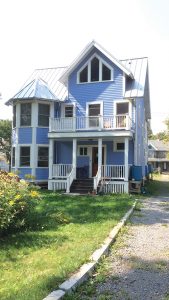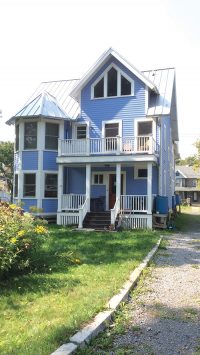 Excerpted from the Summer 2018 edition of Communities, “Eco-Building”—full issue available for download (by voluntary donation) here.
Excerpted from the Summer 2018 edition of Communities, “Eco-Building”—full issue available for download (by voluntary donation) here.
The start of it all: a compost bin
The first Bread and Roses Collective house is a large brick Victorian on a small lot on a residential street in the City of Syracuse, New York. In the early 2000s, when we first built our compost bin, the large lot behind our garage was an overgrown mess of broken box elders, Japanese knotweed, and piles of dumped trash, owned by an unresponsive slumlord. Our compost bin fit right in. As we spent time out there, we began to dream of urban gardens beyond our tiny Food Not Lawns front garden. When the land came up for sale in 2007, we knew we wanted it. What we weren’t so sure about was the derelict, empty house that was attached to it.
The Westcott Street house had been neglected. A tarp covered the back third of the roof, which we had watched disintegrate over the course of five years. Water damage contributed to the whole place stinking of cheap chemical soap and mold, on top of decades of cigarette smoke. The old garage leaned precipitously. If we were to look for a second house to buy, this would not have been it, but to get the land we had to get the house.
The Bread and Roses Collective is a 501(c)3 nonprofit organized for providing affordable, sustainable, low-income housing. The first members of the collective moved into our first house as a rental property in 1997, and eventually organized themselves to form a nonprofit and purchase it from the landlord in 2004. We are a community of activists, often working for local nonprofits and engaged on our own time with various local campaigns, including fights for social and environmental justice. At the same time, we are building the world we want to live in at home, making decisions by consensus and working together to accomplish what none of us alone could do—
Such as buying and renovating a house.
When deciding whether or not to buy the Westcott Street house, the combined factors of already having a large mortgage on our first house and the state of disrepair of this new one gave many of us pause. As in many property transactions, time was of the essence. We came to an agreement that one of our members who could afford to would purchase the house, and at the very least we’d purchase the land from him. We’d take our time to consider the house’s future. In the midst of this, the 2008 housing crisis hit and we ended up getting the property for only $57,000.
Should it stay or go?
Now that it was ours, we went to work pulling out the weeds, clearing out the junk, and expanding our compost operation to collect from a local vegan restaurant and a coffee shop to build the soil for the raised beds of our urban garden. We began to dream about what to do with the house. Despite its being legally owned by only one of us, the decision-making about its future was done collectively from the beginning. We came to the conclusion that the back third of the house was beyond saving. Should we only tear off that part, or should we demolish the whole house? Ultimately, the decision was made to save most of the house and design an addition to fit our needs and dreams. Bread and Roses committed to the project, and financed it through personal loans at interest rates below what the banks could offer.
“In retrospect, it would have been cheaper and easier to tear the whole thing down and build a new house from scratch,” reflects Bread and Roses member Steve. Retrofitting the existing old house for energy efficiency and designing an addition to match its design was costly, in both time and money, but there were benefits too. “By keeping the existing house and carefully deconstructing the elements we wished to change, we saved a lot of material from ending up in the landfill. We also kept the character of the house, which is consistent with the neighborhood.”
Hammering the nails out of every single piece of lath was an inefficient use of our time, although we now have a great supply of nail-free kindling for the highly efficient Avalon wood stove. On the other hand, removing the nails from larger old unpainted boards, installed before the days of pressurized lumber, was well worth it. They are now the sides of the raised beds in the garden.
Dreaming a future
The process in dreaming up what the future house would finally look like was extensive. The collective started by conducting interviews with each member about our hopes and dreams. We were lucky enough to have Simon, a longstanding guest at our weekly potluck who worked for an architectural firm, to guide us through the process of designing the addition of our dreams. He patiently worked with the collective and the architects through a consensus-based design—and the redesign that took place as financial realities set in. A committee of four people led the extensive research and decision process, following the guidelines and broad decisions set by the collective (eight people at that time).
Key to the new addition was a large kitchen. The kitchen at the old house was small even by current single-family home standards. We wanted a kitchen in which we could host parties and workshops; a space that could serve as the hearth of the community. We also knew from experience that one bathroom was not quite enough for second-floor living quarters with five or more bedrooms. Finally, we wanted the first floor of the house to be accessible, both with an eye to accommodating anyone’s eventual disability, and to currently provide accessible meeting space for the local activist community.
Eco-friendly design choices
We strove to build as eco-friendly as possible, but early on we realized that many compromises would have to be made in order to meet the City of Syracuse’s building codes. We couldn’t do strawbale walls, but we could use FSC-certified lumber. We had to hire a contractor to do the actual building envelope, as well as plumbing and electrical. Picking a good contractor is key, and it can be a challenge to find one who will work with a collective. Take the time to read reviews and listen to your gut. You want someone you can trust to build you a good house—this is not a place to cut costs or skimp. We may have saved ourselves many headaches if we’d had that advice.
We did most of the finish work inside ourselves, many of us learning along the way; it is amazing what you can learn from online videos. We taught each other the necessary skills and consulted often with friends and family. We hung drywall, painted, installed the tile and wood floors, cabinetry, countertops, internal doors, and trim. What materials we could, we bought secondhand, scouring Craigslist, the local Habitat for Humanity ReStore, and Freecycle. It was a continuous treasure hunt for the right items, with surprising finds like the granite countertops, or the wooden pews.
Our neighbors were another important source of materials. We carefully watched when things went out on the curb as others remodeled their homes, acquiring a substantial number of doors coated with thick layers of old paint this way. We researched lead paint remediation and developed a process to strip the doors using a heat gun, citrus-based stripper, and careful disposal, always wearing N95 masks, gloves, and changing our clothes and shoes so as to prevent lead contamination elsewhere. When Jessica became pregnant she had her blood tested. Her blood lead levels came back as acceptable, a relief and validation for our process. To be extra safe she only worked on the later stages (staining, poly) of door refinishing through her pregnancy. Her daughter, now nearly three years old, is talkative and clever and has us all wrapped around her little finger.
After living for years in a large, drafty Victorian, we knew the importance of adequate insulation and double-pane, low emissivity (or low-E) windows to ward off the chill of Syracuse winters. We installed high-density foam panels for insulation, between the narrow four-inch studs framing the old portion of the house. If we had built new, this could have been a more eco-friendly material. We sprayed the attic with a thick layer of insulation, resulting in a roof with an R-value of 50.
The light-colored metal roof is an eco design choice. High reflectivity in the summertime means a cooler house, especially when combined with the used ceiling fans we installed in each room. By avoiding asphalt shingles we ensured we could use the rain water on our gardens. We installed homemade rain barrels at each of the downspouts, our contribution to the Save the Rain campaign to keep storm water out of our combined sewers and therefore out of Onondaga Creek and Onondaga Lake.
Most of our lighting fixtures were previously used, and we found some great deals on very pretty fixtures. When the electrician wanted light bulbs in every socket as he worked, Jessica diligently replaced every incandescent light he installed with LEDs. On-demand water heating not only saves energy, it also ensures that no one is upset someone else drained the hot water tank during the last shower!
We used a zero VOC stain with no petroleum distillates and Vermont Natural Coatings’ PolyWhey on all of our woodwork. The polywhey is a groundbreaking product developed in Vermont, made from dairy whey, a dairy industry waste product. It performs well and you can re-coat in a matter of a couple of hours as compared to traditional poly which requires at least 24 hours between coats, so it also makes the whole process much faster. All of the paint on the walls is also zero VOC. This was and is a great benefit, allowing us to work through the winters and while people are living in the house without headaches. By talking about the scale of our project and commitment to zero VOC with the owners of a local paint store, we were introduced to a zero VOC paint that was half the price of anything else we’d seen on shelves. Personal connection is everything.
Impact on membership
The building inspector awarded us a temporary Certificate of Occupancy (COO) in early 2014, allowing new people to move in and expand the number of hands working on the project, which has fluctuated between 10 and 13. We are working towards the permanent Certificate of Occupancy. We were surprised to learn that we had to install all the wood trim before a permanent COO would be granted, despite the rest of the house being fully functional. We had all the trim custom-milled but sent to us unfinished in order to save money. This has cost us in time as countless hours go into sanding and staining each piece. However the finished look, which matches the original trim of the house, is absolutely worth it.
In the 2000s, we would have work-weekends twice a year to maintain and improve the first house. With this project, we moved to work-weekends every month with people working on projects in-between as well. While some dedicated housemates stayed through it all, the amount of work involved did contribute to turnover. For a collective dedicated to providing housing to activists, it is a struggle to balance between building the house, working our day jobs, all while doing our best to contribute to local activist movements. Over the years, 40 members have all contributed to construction of the house. Some people have stayed only a short time; others gave significant years of their life to the project. Only four of us remain from those who made the decision to purchase the house, and I left for a few years. The biggest impact of turnover is the loss of acquired building skills, and the need to train and empower new members. Few people these days come to us with any practical building experience, but they leave with skills and confidence to tackle their own projects. Ultimately our project is not only benefiting our collective, but the community: five of our former members have now purchased and renovated houses nearby.
Even those who leave still appreciate the work they put in, and seeing the progress of the house. “I like coming back and seeing how I left my mark,” observed Sienna when she visited recently, also noting how much she learned in the process. “The skills of building a house are transferable to fighting for a cause: both need organization and people working together.”
The secret to organizing people: good food
The once overgrown lot we originally coveted is now home to an urban permaculture oasis of 10 garden beds, three terraces, fruit trees, and rain gardens, providing the houses with abundant organic homegrown food. Our compost bin collection has grown from one to six with an impressive system of rotation. Many of the damaged trees we cleared were inoculated with oyster and shiitake mushroom spawn and have kept us happily eating mushrooms for years.
As the construction work winds down, Bread and Roses members find ourselves able to return more fully to the activism that brings us together in the first place. As the arena of national politics becomes increasingly chaotic, we find ourselves glad to be in a supportive community, with room to grow, personally and physically. For many members, it’s the coming together in radical spaces with radical support that makes it all worth it. Here, we have bread, and we have roses too.
Lindsay Speer is an organizer on indigenous rights, environmental justice, and energy policy. She is a graduate of Starhawk’s Earth Activist Training Permaculture Design Course. Born and raised in Syracuse, she has lived at Bread and Roses from 2006-2010 and 2015-present. She is rooted deeply in this land and loves its crazy winters and glorious green summers. See @careoftheearth on Twitter.
Excerpted from the Summer 2018 edition of Communities, “Eco-Building”—full issue available for download (by voluntary donation) here.














